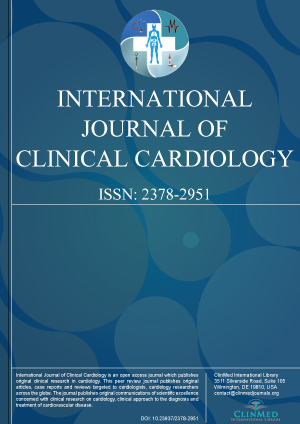Open Access DOI:10.23937/2378-2951/1410080
Transcatheter Closure of Large Bilateral Coronary Arteriovenous Fistulae using Amplatzer Vascular Plugs
Akika Ando, Adnan Bhopalwala and Christian Spies
Article Type: Case Report | First Published: June 23, 2016
A coronary arteriovenous (AV) fistula is defined as a connection between one or more coronary arteries and a cardiac chamber or great vessel, bypassing the myocardial capillary bed. For symptomatic patients, surgical intervention is the standard treatment plan. Recently, the use of transcatheter vascular plugs for the percutaneous closure of coronary AV fistulae has been reported in a few selected cases. We report the case of a 66-year-old woman with diffusely ectatic right and left coronary AV ...
Open Access DOI:10.23937/2378-2951/1410079
Myocardial Infarction in Young versus Older Adults: An Analysis of Differences in Proportion, Risk Factors, Clinical Demographics, Angiographic Findings and in-Hospital Outcomes
Nadim Shah, Christopher Wang, Vanessa Lee, Nicholas Cox, Chiew Wong, Anne-Maree Kelly and Kean Soon
Article Type: Original Article | First Published: May 28, 2016
Background: Coronary heart disease (CHD) remains a major cause of death worldwide. This study looked at the proportions, demographics, risk profile, angiographic data and in-hospital outcomes of young versus older myocardial infarction (MI) patients presenting to a community teaching hospital in Melbourne, Australia. Methods: This was a retrospective study of patients presenting prospectively, with acute MI between August 2013 and July 2014, who demonstrated coronary stenosis ≥ 50% on inva...
Open Access DOI:10.23937/2378-2951/1410076
Effect of Exercise Training on Heart Sympathetic Activity and Lung Function in Mexican obese Adolescents
Benigno Linares-Segovia, Estela Nunez Lemus, Manuel Lara Marquez, Rogelio Torres Guzman, Juan Manuel Guizar-Mendoza and Norma Amador-Licona
Article Type: Research Article | First Published: April 28, 2016
Introduction: The aim of this study was to evaluate the short term effect of a moderate-intensity physical activity program on heart sympathetic activity and lung function in Mexican obese adolescents. Materials and methods: We performed a longitudinal study in 38 healthy obese adolescents (24 female and 14 male). Subjects were submitted to aerobic exercise training during 90 minutes for 16 weeks, 5 days per week. Before and after the intervention program, blood pressure, anthropometric measurem...
Open Access DOI:10.23937/2378-2951/1410073
Radial-Linear Ablation in Peri-pulmonary Vein Area Prevents Inducible Atrial Fibrillation in Dogs
Xue Zhao, Yinxiang Zhu, Xiang Mei, Jiayou Zhang, Jianqiang Hu, Wenliang Lu, Xingui Guo, Li Dai, Kailei Shi and Zhenguo Liu
Article Type: Research Article | First Published: March 16, 2016
A total of 22 dogs of both sexes (5-7 years old) were divided into two groups: 10 in control and 12 in ablation group. Multiple radial-linear lesions were created from PV orifice to peri-PV area in the dogs with CARTO guidance. The control animals went through the same procedure except ablation. AF inducibility was evaluated before and immediately after the procedure. All animals had inducible AF (100%) by atrial pacing combined with or without isoproterenol at baseline....
Open Access DOI:10.23937/2378-2951/1410072
Increased Corrected QT Interval (QTc) in First Nations Women of Northern British Columbia with Systemic Lupus Erythematosus (SLE)
Fritha A Munday, Sirisha Asuri, Sarah McIntosh, Heather Jackson, Anthony Tang and Laura Arbour
Article Type: Original Article | First Published: January 30, 2016
Long QT Syndrome (LQTS), a genetic predisposition to sudden cardiac death is defined by a prolonged corrected QT interval (QTc) measured on electrocardiogram (ECG). A participatory research project has been underway with the Gitxsan of Northern BC for more than ten years where the condition (LQTS1) is common, due to a founder mutation (V205M) in KCNQ1. It is effectively treated with beta blockers and avoidance of QT prolonging drugs. Some chronic conditions are also known to increase the QTc, wh...
Open Access DOI:10.23937/2378-2951/1410071
Effects of Erythropoietin Administration on Cardiomyocytes in Landrace/Large White Pigs after Ventricular Fibrillation
Armando Faa, Gavino Faa, Eliana Di Felice, Pietro Pampaloni, Daniela Fanni, Daniele Scano, Clara Gerosa, Maria Elena Pais, Panagiotis Vasileiou, Dimitrios Barouxis, Pavlos Lelovas, Theodoros Xanthos, Charalampos Pantazopoulos, Apostolos Papalois and Nicoletta Iacovidou
Article Type: Research Article | First Published: January 28, 2016
Ventricular fibrillation was induced via a pacing wire forwarded into the right ventricle in 20 female Landrace/Large-White pigs, allocated into 2 groups; the experimental group treated with a bolus dose of 5,000 U/Kg recombinant human erythropoietin and the control group which was administered saline. Cardiopulmonary resuscitation (CPR) was performed immediately after drug administration....
Open Access DOI:10.23937/2378-2951/1410070
Spontaneous Coronary Artery Dissection: Report of 6 Cases and Literature Review
Adolfo Ferrero Guadagnoli, Miguel A Ballarino, Carlos R Leonardi, Alejandro E Contreras, Eduardo J Brenna and Jonathan Miara
Article Type: Research Article | First Published: January 27, 2016
We present our recent casuistry on such an interesting issue as coronary dissections. Provide data to assist the diagnosis and treatment of this disease. Spontaneous coronary artery dissection is a non-traumatic and non-iatrogenic separation of the coronary artery walls. It is a rare cause of acute coronary syndrome, mainly affecting women with no significant cardiovascular risk factors and has varying presentations from mild chest pains to sudden cardiac death....
Open Access DOI:10.23937/2378-2951/1410069
Left Ventricular Assist Device Placement through Left Thoracotomy in Difficult Scenarios
Lyndsay M. Mueller, Samuel H. Cho, Timothy Fritz and Asghar Khaghani
Article Type: Case Report | First Published: January 18, 2016
Standard surgical approach to the implantation of a Left Ventricular Assist Device (LVAD) is through a median sternotomy. The inflow cannula is attached to the apex of the left ventricle, while the outflow graft is usually attached to the ascending aorta. We present 2 patients with prohibitive chest wall abnormalities who underwent left thoracotomy for LVAD placement, and the outflow graft alternatively attached to the descending aorta....

